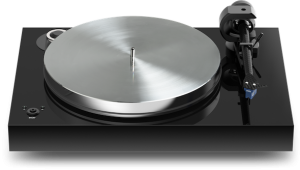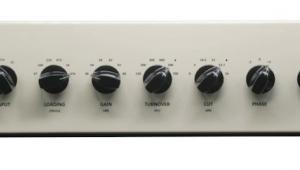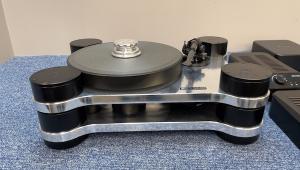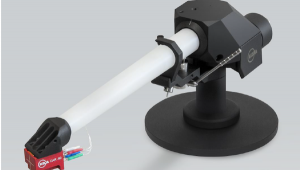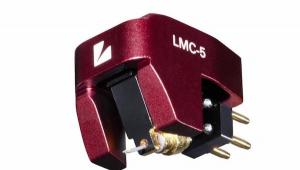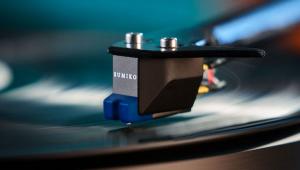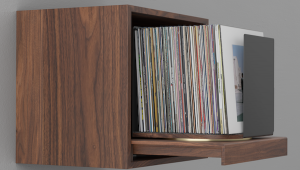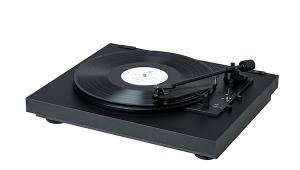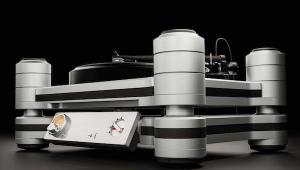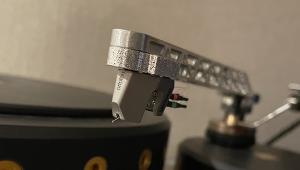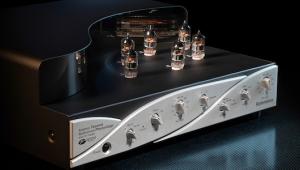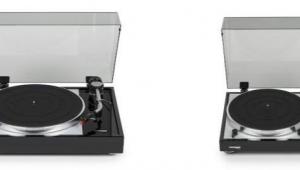I've never had one of these but will probably try this out if it reviews favorably.
Fozgometer V2 From Musical Surroundings
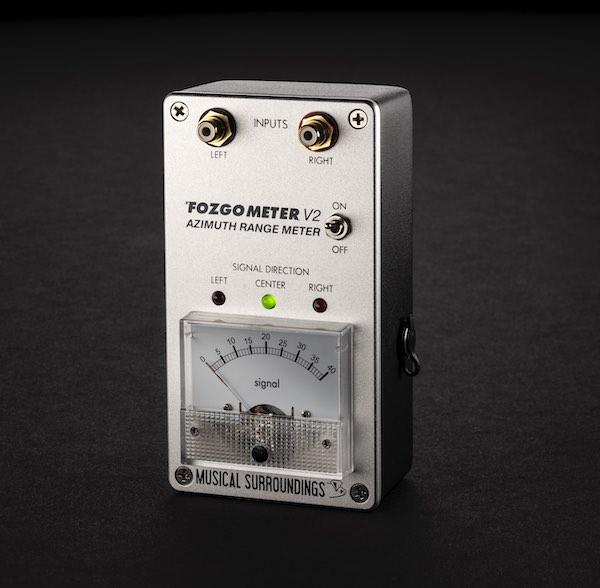
As every AnalogPlanet reader surely knows, proper azimuth is rarely though sometimes achieved when the head shell is parallel to the record surface and the cantilever is perpendicular. The Fozgometer helps you set azimuth electronically by measuring channel crosstalk rather than setting azimuth visually. It's best used with the Analogue Productions "Ultimate Test Record".
The V2 Fozgometer features a "sensitive 'Log Ratio Detector' that measures cartridge channel separation and balance. V2 is said to feature higher sensitivity and greater accuracy. It includes a new meter design and can be used with either battery or A.C. power, for improved accuracy.
The original Fozgometer was introduced in 2010. Hard to believe that many years have passed. The new Fozgometer costs $400. A review sample should be arriving soon.
- Log in or register to post comments


Would the result from this method be the same as with the Fozgometer2? https://www.analogplanet.com/content/crazy-little-thing-called-azimuth-p...

Get a line level from a hardware store. They're made of lighter- than-light plastic and is about 3 inches in length and grooved underneath. Simply set the stylus on the record and place something (coins?) under the cartridge, just touching the underside. Gently place the level on the arm of the tonearm and adjust the tonearm height til it's level. That's it

...I don't even know where to begin with that!
I would suggest you take a gander at this and make sure you watch the video at the bottom of the post: https://www.wallyanalog.com/post/finally-a-video-explaining-azimuth
An additional tidbit: stylus/cartridge manufacturers (of which there are three main ones) have a +/-2 degree tolerance at very best - but most are +/-3 degrees - for the mount of the stylus on the cantilever relative to the coils.
Manufacturers align the coils - not the stylus - when optimizing for proper alignment in the magnetic flux field in order to maximize channel separation.
I once purchased 100 of those little bubble levels for a product I was thinking of making. I then set about determining their accuracy. I had to throw away all but about 30 of them as they were too inaccurate to be useful for analog setup where small changes make a difference mechanically and sonically.

Did I read correctly, you come out with an electronic azimuth/zenith measuring/adjustment tool? When about? Will be interesting how to compensate for zenith errors when adjusting the cartridge with normal jigs.

...I will restrict my comments on this post to be in support of the Fozgometer. The functional principle behind the Fozgometer is the right one: to get maximum stereo separation from your cartridge you must measure crosstalk electrically. I support the electrical measurement method as it is the only method to ensure the best sonic results on the azimuth axis.

What are your thoughts on measuring it acoustically?
My method has been to start with stylus perpendicular to platter and play a 'balance test' track, noting crosstalk in the opposite channel with an SPL meter. I do this for both channels, adjust azimuth, rinse and repeat until the crosstalk is equal (or within a dB or two), then reset the balance and call it a day.
I'm sure a Fozgometer or whatever you're working on would be more accurate/repeatable, but do you think what I'm doing with a dollar-bin test record and free SPL iphone app is better than nothing?

...which is not the same as maximizing channel separation and have only a loose correlation to each other. I never worry about channel balancing a cartridge at all unless I find a problem in unequal output - which is exceedingly rare.

Thanks for responding - sorry I'm only reading it now instead of over the weekend.
I think I failed to properly explain what I meant by "reset the balance and call it a day." What I actually do is continue to play the balance test track, but I now note the SPL coming from the speaker on the SAME channel as the 1kHz modulated groove on the record - and adjust the balance knob until both channels are equal.
So FIRST, I adjust azimuth until the CROSSTALK SPL measured in each speaker as close to equal as I can get it ... THEN I adjust the balance until the INTENDED SPL measured in each speaker is exactly equal in dB ... note, the balance knob may not be at exactly 12:00, but the output of each speaker is the same.
So perhaps I'm totally off-base, but if I equalize crosstalk by adjusting azimuth... AND I equalize intended output using the balance knob... (AND neither stylus nor balance knob is more than a degree or two from vertical...) Have I NOT maximized channel separation?

...isn't helping to maximize channel separation at all. It is only changing the balance between channels. I suggest you end that practice as there are better ways to determine whether your channels need balancing that don't involve measurement of crosstalk.

I too pay little attention to channel balance as that is normally never an issue with a cartridge. I have the Foz Meter V1.0 and use it to set channel separation/crosstalk.
I play tracks 2 and 3 of the AP test record and disconnect the RCA with the modulated track and look for the lowest reading in the unmodulated channel, then do same for other channel and set so they match as close as possible. I can get my Delos to about 2 clicks off zero on each channel.

With V2, disconnecting one cable at a time before testing has the needle almost pinned before a track is played. Not sure if V1 does the same? That said, I don't think I can use these procedures with V2 because both LH & RH cables need to be plugged into the Fozgometer to begin at zero

Thanks. I tried this. I had to move the azimuth about a degree, and it sounds quite a bit better (Shibata stylus)

I have one, got it from a fellow who set up his table and didn’t need it anymore. Bonus for me, got it cheap. It is good and was surprised how off my MM stylus replacements for my Shure V15 MK V MR were. I contacted the manufacturer in Japan who said they perform extensive tests to make sure they are fine but would not tell me what those tests are. Maybe sell mine and get this Version 2.0
I would also like to know if the AnalogMagik software is worth the outlay, so far only a handful of people report having it and liking it but no reviewers can get their hands on one to test its efficacy. But the idea of software driven applications to solve problems of VTA, Azimuth, SRA, and anti skate is very compelling.

Version 1 - cheap on Hifizero.com and similar meta sites - works great with Analogue Productions' "Ultimate Test Record." It was quick and easy to get my Ortofon Cadenza Black MC sounding 'right.' A useful and reassuring tool worth seriously considering :-)

Why would you get this when you can get a digital oscilloscope for $329 on Amazon?

The learning curve with an oscilloscope is much steeper than using the Fozgomter. Also, the Fozgomter is smaller and can be tucked away.

And I am sure with some effort I can master it, as I love to tinker like the next guy, but I just want to get on with the job of setting azimuth and enjoy the music.

This can be accomplished for a lot less money and little more effort by using your AC voltmeter (you have one, don't you?), made easier by reading out in dbm as many do. Nearly any test LP has tones in only the left and right channels. Adjust your azimuth as you put your ACVM leads on what's easiest (in my case, the speaker terminals) to maximize the output on the channel being played while minimizing the output of the 'silent' channel. It is an iterative process, but apparent when it's dialed-in, 10 minutes max. If measuring at the speakers, it may be useful to set a system balance baseline by playing a test CD tone to account for any system balance offset.
Nothing against the Fozgometer, but even a decent multimeter is far cheaper, and useful for a lot more than just a once-per-cartridge azimuth tweak.

Michael, have you tried Analogmagik? I wander what you think about it. I have it and I love it. IMHO it is much better than Fozgometer V2, which I own as well, when setting the azimuth.
Thanks in advance.

Interesting, just had a conversation with someone who owns it and doesn’t recommend it. He said it’s great for azimuth adjustment, but for anything else it is just too expensive. He says they claim that a good setup is necessary and then you use it to make minute adjustments to see low numbers so that you’re confident in your setup. To him that simply wasn’t worth it. He had difficulty adjusting SRA for two different cartridges because distortion numbers changed depending where you were on the test tone track. You had to be 100% sure you were on the same point of the test tone for both cartridges when adjusting. He concluded by saying there were too many variables to be able to conclude that you were within 0.5-1% distortion numbers as AM says you can. He hopes V.2 is better. I am curious what you think of the software and the criticisms.

Your friend is right on the money. I do not know if the frustration, that I sometimes share, is a matter of how sensitive the app is or the changes across the track is a function of all the variables.
Although it looks like Michel is fairly on the side of Wally, it would be great to hear what he has to say.
I am about to buy an oscilloscope to verify Analogmagik. I think it is insane to spend $400 on an Fozgometer when you can buy something much more versatile and likely accurate for less that $400. Yes it is bigger, but is someone to sacrifice accuracy for space, really?
With all the boxes we save to meet the ridiculous expectation that in case you need to ship a component back for repair you must use the original box. Turntables, I get it, but almost anything else could be much better packed with a new box.

I would think Michael would like to review it but I beleve Analogmagik refuses to send a sample for review. Either way, I have heard enough frustrating comments from people to make me stay away for the moment.
One day I will take the plunge and learn how to use an oscilloscope for azimuth and anything else it can do. Cheers and enjoy!

Here is a possible explanation for why the changes across the tracks.
As the the Stylus move away from the Null Point, the alignment angle basically changes, so measurement will either drift UP or drift down depending on location on the LP.
Would not be this true for an oscilloscope reading?
A normal oscilloscope, depending the settings will likely have different settings than Analogmagik.
For example, Sampling rate, how many measurements before displaying a number, 1 sec, 5 second, 10 second and what type of averaging to use.
When V2 comes out the L and R for the azimuth will be in the same track, thus AM will be measuring L+R at the same time.
Hopefully it will be more user friendly for all its functions AND the use of an oscilloscope will only corroborate/confirm AnalogMagic's numbers.
It would be great if someone did an honest review/tutorial on these tools highlighting the pros and cons of each tool.
But I do not think we will ever get someone to do the comparison with explanation for their findings.

I'm a DIY kind of guy, but for that kind of money, for something you only do once (not a compulsive cartridge upgrader) I'd rather just take the TT to someone. Better still, use a 'scope. I already mastered the "learning curve" decades ago and often help students to. And can borrow one any time I want.
Realistically, though, I've always just used the eyeball/level method.

I am experiencing odd issues such that a new 9v battery and the SMPS given very different readings on the meter. I reached out to the manufacturer. I will post an update. Unit is calibrated.

I’ve always had a thing for bad decisions and worse women. Long story short, I ended up in a situation where someone decided to cry wolf, and I needed help fast. Wasn't even sure where to begin, but then I remembered seeing https://crimlawcanada.ca/ pop up in a Reddit comment thread. Looked into it, and it had exactly the kind of no-BS energy I needed. The fact that they’ve been involved with high-level courts all over Canada sealed the deal for me. Real talk, they handled it like pros.


